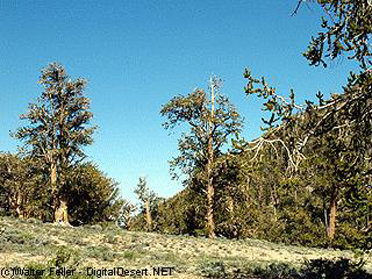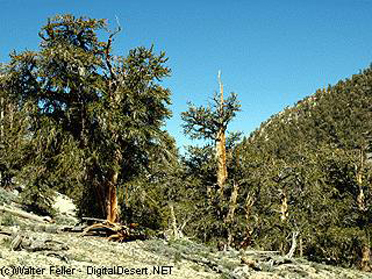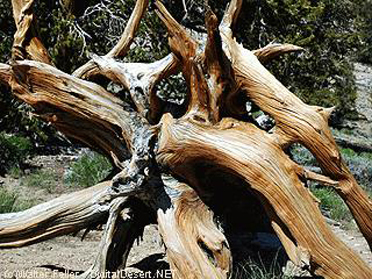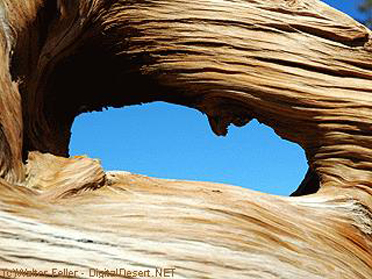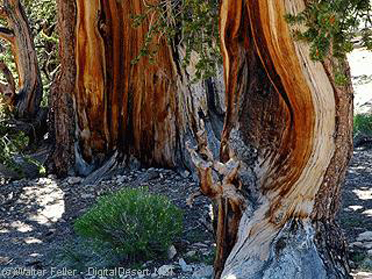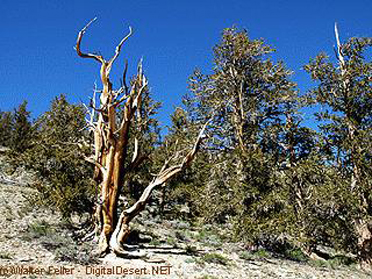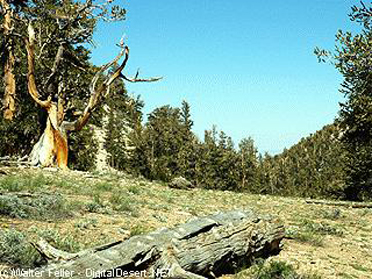--
Bristlecone Pine Forest
A Journey Through Time - NPS
Standing as ancient sentinals high atop the White Mountains of the Inyo National Forest,
the Great Basin Bristlecone Pines rank as the oldest trees in the world, having achieved
immense scientific, cultural and scenic importance. While the oldest trees are found in
the mountains of Eastern California, Great Basin Bristlecone Pines (Pinus longaeva)
are scattered throughout the high mountain regions of Nevada and to a lesser extent, Utah.
A cousin, the Rocky Mountain Bristlecone Pine (Pinus aristata), is located throughout
the eastern Rocky Mountain region in Colorado and New Mexico. An isolated population of
the aristata is also located near Flagstaff, Arizona. A third member of the
bristlecone pine family, the Sierra Foxtail pine (Pinus balfouriana) is located in
the southern Sierra range and in isolated groves in northern California.
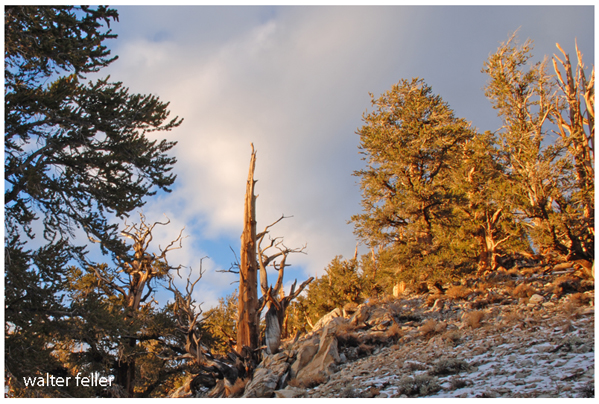
Originally classified as a foxtail pine because of the needle arrangement (like a cat's or
fox's tail), these trees were redesignated in the late 1800s and named bristlecone due to the
long, prickly "bristle" on the immature cone. In 1963, Dr. Dana K. Bailey determined that there
were significant genetic and physical differences between the bristlecones in the Great Basin
and those in the Rocky Mountains.His research efforts resulted in another redesignation into
two separate species named bristlecone: the Rocky Mountain Bristlecone Pine and the Great
Basin Bristlecone Pine.
The the White Mountains, the ancient bristlecone pines seem to show a preference for growing
on the white, rocky soil that gives the name to this mountain range. This is Dolomite, a type
of limestone created under the warm, shallow sea that once covered this area. This Dolomite is
very alkaline in soil chemistry and thus makes for very challenging growing conditions:
precisely why the oldeset trees are found here. The bristlecone pines don't actually "prefer"
this soil type. Other plant species have a difficult time growing in it and the bristlecones,
because they have adapted to this high alkalinity, have a chance to get established and grow
in a near competition-free environment. In other areas such as the Great Basin National Park,
bristlecones have established themselves on soil types that are equally inhospitable to all
but the most hearty of survivors: the ancient bristlecone pines.
Every year, trees produce a new layer of wood just under the bark. During a dormant period,
or time of slower growth, a narrow band of dark wood is produced, which when added to the
lighter colored "summer growth," produces what we see as a distinguishable tree ring. In wet
years, the width of this new wood is usually wider than in years of drought. The bristlecone
pines are known as great recorders of these climatic variances due to their high sensitivity
to changes in annual precipitation. Scientists who study and research tree-ring patterns
are known as dedrochronologists; they are called dendroclimatologists if they specialize in
climate research through tree-ring records.
Researchers use a device called an increment borer to extract a small cross-section of a tree.
This sample provides a look at each tree ring and enables scientists to determine both the
both the age and the pattern of its growth. There are many trees in the bristlecone pine
forest of the White Mountains that exceed 4,000 years of age, and are still growing!
Bristlecone pine wood that has fallen to the ground can remain intact for thousands of years
in the cold, dry climate of the White Mountains. Using a cross-dating technique that overlaps
tree-ring patterns of living trees with the still intact patterns of dead wood, scientists
have assembled a continuous tree-ring chronology extending nearly 10,000 years. This
bristlecone pine chronology, developed here in the White Mountains by the University of Arizona
researchers, is the longest in the world and provides an unequaled look into past climatic and
environmental conditions.
For many years now scientists, archeologists and historians have relied on a system known as
radio-carbon dating. It was discovered back in the 1960s that this process was flawed and
needed to be calibrated. The wood from the bristlecone pines helped correct this process by
providing samples that could be precisely dated. Scientists dated these samples by counting
their growth rings; they then measured the amount of carbon-14 (C-14) in those samples. They
discovered that the radiocarbon dating process was providing dates that were "too young"
and established a calibration factor to correct the dating process.
Faulty C-14 data obtained before the bristlecone pine calibration was then re-examined and
corrected. Archeologists found that some artifacts discovered in Europe were actually
1,000 years or more older than previously thought. This revision of archeological site
dates led historians to a reinterpretation of cultural diffusion thoughout the Mediterranian
and European areas. Because the bristlecone pines of this grove provided the wood to
recalibrate the radiocarbon dating method, they have become known as the trees that
rewrote history.
Also see:
Route Guides
Route 8 - Mazourka Canyon
Creosote rings have been dated at over 11,000 years, much older than the oldest living trees, the bristlecone pines at the crest of the Inyos (Route 11). ...
Route 11 - Ancient Bristlecone Byway
Beyond this the pinyons end and the high-elevation pines, limber and bristlecone, begin. Both have needles in bundles of five but bristlecone needles grow ...
Ecological Subsections
Panamint Range: Southern Great Basin Ecological Subsections
Forests and woodlands: Bristlecone pine series, Curlleaf mountain-mahogany series, Limber pine series. Climate. The mean annual precipitation is about 4 to ...
Inyo Mountains: Southern Great Basin Ecological Subsections
Limber pine series and Bristlecone pine series occur at high elevations in the Inyo Mountains. ... Forests and woodlands: Bristlecone pine series, ...
White Mountains Mono Ecological Subsections
Forests and woodlands Aspen series Bristlecone pine series Curlleaf mountainmahogany series Limber pine series Lodgepole pine series Singleleaf pinyon ...
Southern Great Basin Ecological Subsections
... Singleleaf pinyon series, Utah juniper series, Low sagebrush series, Shadscale series, Mixed saltbrush series and Bristlecone pine series. ...
Mono Ecological Subsections
... Singleleaf pinyon series, Shadscale series, Low sagebrush series, Jeffrey pine series, White fir series, Aspen series and Bristlecone pine series. ...
Grapevine Mountains: Southern Great Basin Ecological Subsections
Forests and woodlands: Bristlecone pine series, Curlleaf mountain-mahogany series, Singleleaf pinyon series, Singleleaf pinyon - Utah juniper series, ...
Wilderness
Inyo Mountains Wilderness
... lush riparian areas in most of the canyons on the eastern slope and pinyon-juniper woodland, bristlecone and limber pine on the higher reaches. ...
Communities
Big Pine California
Big Pine is the gateway to the Ancient Bristlecone Pine Forest in the White Mountains and the Eureka Dunes in the extreme north end of Death Valley National ...
Bishop, California
Bishop is a city located in Inyo County ...
Region
Basin and Range Geomorphic Region
Another graben, Owens Valley, lies between the bold eastern fault scarp of the Sierra Nevada and Inyo Mountains. The northern ...
Eastern Sierra
Eastern Sierra Valleys & Mountain Areas Eastern Sierra SUV Tour/Trip Guides · Bristlecone Pine Forest · Mono Lake · Bodie Ghost Town · Convict Lake ...
Tree Dominated Habitats
Subalpine Conifer - Ecosystems & Wildlife Habitats
These include Engelmann spruce, subalpine fir, mountain hemlock, western white pine, lodgepole pine, whitebark pine, foxtail pine, bristlecone pine, ...
Alpine Dwarf-Shrub Habitat
The Alpine Dwarf-Shrub habitat vegetation may sometimes constitute part of the Bristlecone Pine Forest where they intergrade. The Alpine Dwarf-Shrub habitat ...
Lodgepole Pine - Ecosystems & Wildlife Habitats
Bristlecone Pine Forest Above 11000 feet elevation, in the alkaline soils of the White ... Forests and woodlands: Aspen series, Bristlecone pine series, ...
Montane Hardwood Wildlife Habitats
Middle elevation associates are Douglas-fir, tanoak, Pacific madrone, California-laurel, California black oak, and bristlecone fir. ...
White Fir Habitat
Singleleaf pinyon series, Shadscale series, Low sagebrush series, Jeffrey pine series, White fir series, Aspen series and Bristlecone pine series. ...
Pinyon-juniper - Ecosystem
mesquite at the lower elevations and range up through shadscale, blackbrush, Joshua tree, pinyon-juniper woodlands, to limber pine and bristlecone pine. ...
Jeffrey Pine - Ecosystems & Wildlife Habitats
Singleleaf pinyon series, Shadscale series, Low sagebrush series, Jeffrey pine series, White fir series, Aspen series and Bristlecone pine series. ...
